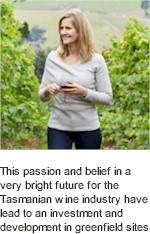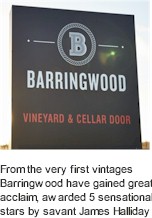


The first vines at Barringwood’s original Lower Barrington vineyard were planted on the site of a working sawmill in 1993. In 2012 Vanessa and Neville Bagot were visiting Vanessa’s beloved home state from their home in Sydney when they were made aware that Barringwood Park Vineyard (as it was then called) was for sale. A single visit to the stunning site along with wine tasting captivated them, perhaps it is too simplistic to say they liked the wine so much they bought the vineyard, but it’s not too far from the mark. While the purchase of the vineyard was really intended as a charming distraction from their busy professional lives in Sydney, the reality has been quite different. The distraction rapidly became an obsession, particularly for Vanessa who has truly found her passion. Indeed she is never happier than when she is hand pruning in the dead of winter.

This passion along with a belief in a very bright future for the Tasmanian wine industry have lead Vanessa and Neville to invest in and develop two greenfield sites, one in Cranbrook on the East Coast and one on the outskirts of Evandale. A total of 33 hectares of vines were planted across the two sites in 2016, with further planting planned. Along with the orginal vineyard in Lower Barrington, Barringwood has planted two new vineyards in Evandale and Cranbrook. All the vineyard operations focus on producing low yields of premium grapes, the key to achieving this is an unwavering attention to detail. Vines are trained on a combination of vertical shoot positioned (VSP) trellising and a modified Scott Henry. Hand pruned and hand picked and use minimal drip irrigation. Preventative management strategies for pests and diseases to minimise the use of chemical.
Barringwood's Lower Barrington vineyard is located on a steep north facing slope over looking the Don Valley toward Bass Strait. The site rises to an elevation of 276m. A long mild growing season perfectly suited to creating premium quality fruit from the classic cool climate varieties of Pinot Noir, Pinot Gris and Chardonnay, as well as the more usual Pinot Muenier and the exotic Schönburger.
Evandale is a gently rolling 120 hectare site located on the Northern outskirts of the historic town of Evandale near Launceston. Planting was commenced in 2016 with 20 hectares of Pinot Noir, Chardonnay, Riesling and Pinot Gris. The second stage of this development added further hectares. Planted to the site of an historic super fine merino farm established in 1840, Barrington's East Coast vineyard was developed in 2016 with the planting of nine hectares of Pinot Noir.

From the very first vintages Barringwood wines have gained acclaim and continue to do so. The vineyard has been awarded 5 stars by James Halliday for each of the past four years and in a recent Winestate Magazine Tasmanian regional tasting Barringwood Pinot Gris, Mill Block Pinot Noir and Schonburger were all the highest rated wines in their categories. The Schonburger went on to win 2015 Winestate Wine of the Year in the alternative whites category. All aspects of the operation are hands on. A great passion for Pinot Noir and Chardonnay is at the core, mainly in the drinking of it. A truly challenging way to enjoy your favourite pastime, planting vines and farming the vineyard, picking your own grapes and making the wine itself. Waiting until it ages and opening the bottle only when it's ready. It's a labour of love but the effort is well worth the rewards. Barringwood vineyards will continue to produce truly stunning wine.